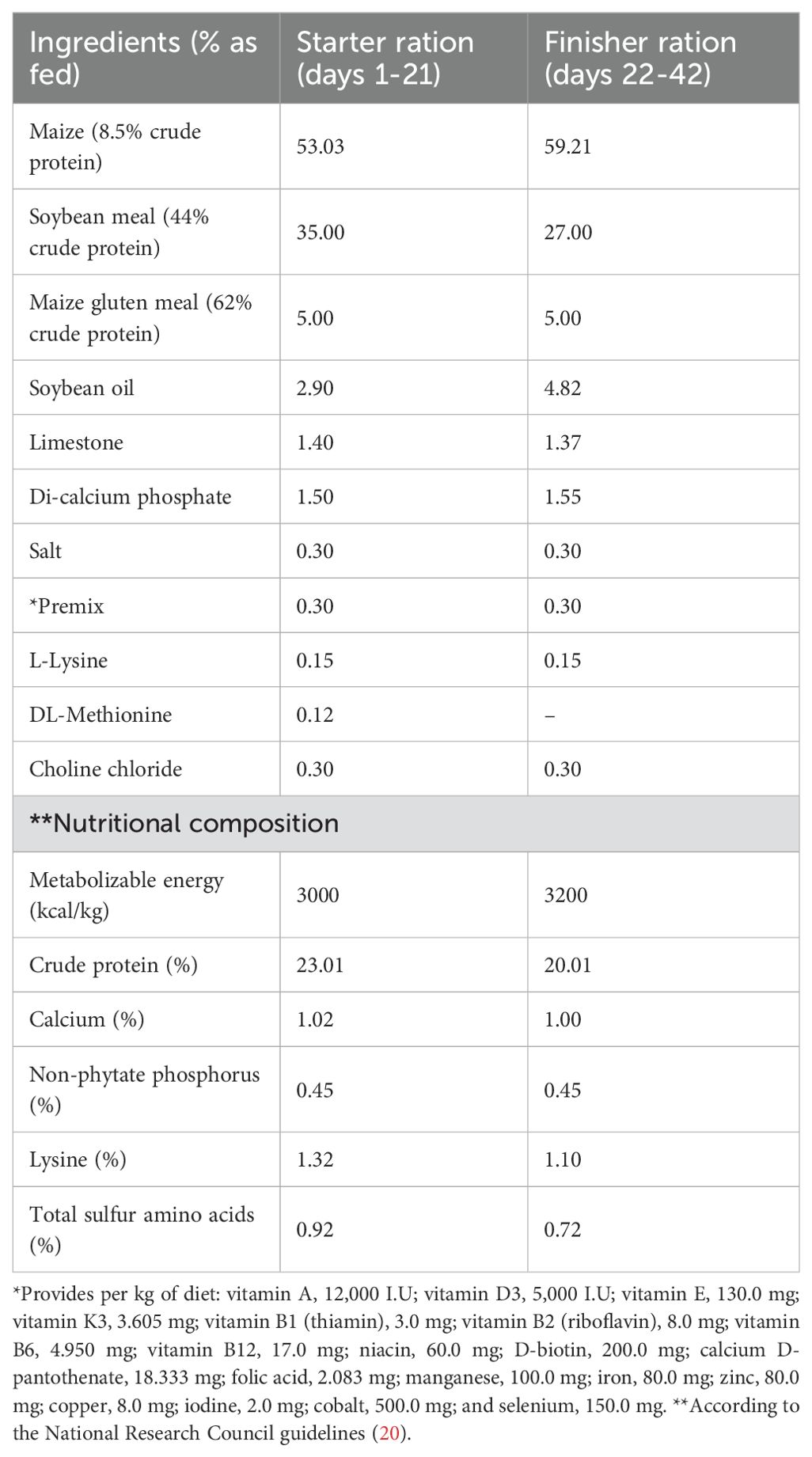- 1Poultry Department, Faculty of Agriculture, Zagazig University, Zagazig, Egypt
- 2Department of Animal Production, College of Food and Agricultural Sciences, King Saud University, Riyadh, Saudi Arabia
- 3School of Biosciences and Veterinary Medicine, University of Camerino, Matelica, Italy
- 4Department of Biology, College of Science, United Arab Emirates University, Al Ain, United Arab Emirates
- 5Department of Animal Production, Faculty of Agriculture at Moshtohor, Benha University, Benha, Egypt
Introduction: This study examined the effects of adding thyme oil (TO) to broiler diets on growth performance, intestinal health, immune organ indices, blood biochemical parameters, and economic feasibility.
Methods: In a completely randomized block design, five groups of 1-day-old broiler chicks (n=300) with five replicates, each consisting of 12 chicks, were used. A basal diet (BD) was supplied to the control group, whereas the other groups received BD supplemented with 75, 150, 225, and 300 mg/kg of TO.
Results and discussion: The findings indicated that TO improved final body weight (BW), total body weight gain (BWG) and the feed conversion ratio (FCR), without affecting feed intake (FI). Groups fed 150, 225, and 300 mg/kg of TO showed higher levels of digestive enzymes (P<0.05) than the control. Supplementation with TO elevated immune organ indices, with statistical significance (P<0.05) noted in birds receiving 150, 225, and 300 mg TO/kg for the spleen, thymus, and bursa of Fabricius indices, compared with the control group. Moreover, total protein, globulin, immunoglobulin (IgM and IgG), and complement component 3 were significantly (P<0.05) higher by TO at 150, 225, and 300 mg/kg than at 0 and 75 mg/kg. Blood Ca and Mg were significantly (P<0.05) increased by the application of 150, 225, and 300 mg TO/kg, whereas the Fe level rose (P<0.05) by 75 and 150 mg/kg compared with the control. TO at 150, 225, and 300 mg/kg increased hemoglobin (Hb), counts of white blood cells (WBCs), and red blood cells (RBCs) compared with the control. The application of TO decreased (P<0.05) aspartate aminotransferase (AST) levels in a dose-dependent manner. Creatinine and urea levels were significantly decreased by TO at 225 and 300 mg/kg compared with the control. Lipid peroxidation was significantly (P<0.05) decreased by TO supplementation (150, 225, and 300 mg/kg), whereas superoxide dismutase (SOD), total antioxidant capacity (TAC), catalase (CAT), and reduced glutathione (GSH) were significantly increased by the application of 150, 225, and 300 mg TO/kg compared with the control. Lower levels of total cholesterol, triglycerides, low-density lipoprotein (LDL), and very low-density lipoprotein (VLDL) were observed at 75, 150, 225, and 300 mg TO/kg compared with 0 mg/kg. In comparison, higher high-density lipoprotein (HDL) levels were observed for 225 and 300 mg of TO/kg compared with the control. The net revenue and economic efficiency of TO-supplemented treated broilers were improved during the experiment (1–6 weeks of age). The best values of economic indices were observed in the group receiving 150 mg/kg of TO. Collectively, supplementation with dietary TO enhanced growth performance, intestinal health, immune system development and function, liver and kidney function, and antioxidant capacity, regulated the lipid profile, and improved economic feasibility.
Introduction
The global reduction of antibiotics in poultry has driven interest in natural alternatives, including microbial and phytogenic sources (e.g., probiotics, prebiotics, and essential oils), which exhibit growth-promoting, antioxidant, antimicrobial, and immunostimulant effects in animals (1–8). Thyme (Thymus vulgaris L.) is a Mediterranean herb used for food, medicine, and decoration due to its high bioactive component content and ethnopharmacological significance (5–8).
Thyme plants’ flowers, leaves, and oil can help people with various ailments. It exerts antihypertensive (9), anticancer, antiviral, antifungal (10), and antimicrobial and anti-inflammatory properties (11). Additionally, thyme is a viable source of natural feed additive because it increases food stability and reduces lipid oxidation over the course of food storage (animal products) (12). Thyme oil (TO) stability during industrial scalability depends on formulation and processing. This stability is critical for bird efficacy and palatability, as it is sensitive to temperature, oxygen, and light, which can lead to decreased stability, peroxidation, and reduced feed intake (12).
Thymol and carvacrol, the key components of thyme essential oil, can improve poultry health (5, 12, 13). Moreover, thyme extract (1 mL/L drinking water) alleviates growth impairment in broilers fed low-protein diets (13). Oke et al. (14) reported that thyme can help birds under oxidative stress by increasing their antioxidant levels.
Increased serum antioxidant capacity and decreased mortality rate were observed in broiler diets supplemented with thymol (15). Furthermore, thyme has antimicrobial and antiviral characteristics that impact numerous microorganisms (5, 15). The application of thyme essential oil or thyme powder in broiler feed elicited immune system stimulation (16) and stress reduction (17).
Data on the use of TO on intestinal architecture, digestive enzymes, and the economic efficiency of poultry are scarce, and previous findings (15, 17–19) on TO supplementation in broiler chicken diets yielded contradictory conclusions. Therefore, the objective of the present study was to explore the impacts of dietary TO supplementation at graded levels (75, 150, 225, and 300 mg/kg) on a wide range of measurements including intestinal digestive enzymes, cecal microbiota, immunity, antioxidant status, carcass characteristics, some hematological parameters, blood minerals, and blood markers of liver and kidney function, besides the growth performance indices and economic efficiency. The trial was terminated at 42 days of age, which corresponds to the typical slaughter age for commercial broilers under intensive management systems. This timing ensures the assessment of TO effects throughout the birds’ entire commercial growing cycle, including both the starter and finisher phases.
Materials and methods
This study was conducted at a private poultry farm in San El Hagar, Sharkia Governorate, Egypt, in accordance with the ethical guidelines of the Poultry Department at Zagazig University, Zagazig, Egypt. All laboratory analyses, experimental procedures, and protocols adhered to the ethical standards set by the Committee of Animal Care and Welfare at Zagazig University, under Ethical Approval Number ZU-IACUC/2/F/313/2023.
Birds were monitored daily for health, including mortality and morbidity, and humane endpoints were applied. Any animal showing severe signs of distress or illness was treated or humanely euthanized following standard protocols.
Phytoextracts tested and their characteristics
The TO used in this study was obtained from El Hawag Company for Natural Oils, located in Cairo, Egypt. Gas chromatography-mass spectrometry (GC-MS) analysis identified the primary compounds of TO as follows: 48% thymol, 17.5% γ-terpinene, 13.6% p-cymene, and 11% carvacrol.
Experimental birds and design
Five groups of unsexed Arbor Acres 1-day-old broiler chicks (n=300; 5 replicates of 12 chicks each) were used. Five dietary treatments were provided: a control diet (basal diet) and four test groups with varying TO concentrations (75, 150, 225, and 300 mg/kg diet). The replicates were kept apart in 100 × 120-cm pens. Birds were randomly distributed into pens at the beginning of the experiment to ensure homogeneity in body weight (BW) among groups. Pens were subsequently assigned to dietary regimens at random to eliminate bias and confounding factors.
A nutritionally balanced basal diet was carefully formulated to meet the nutritional requirements of broiler chicks throughout their growth period, from days 1 to 42, in accordance with the National Research Council guidelines (20). The detailed chemical composition and nutrient content of the basal diet are presented in Table 1. The same care and hygienic circumstances were used to raise each bird.
Chicks were reared with unlimited accessibility to water and feed. During the experiment period, the birds were raised at a standard ambient temperature (decreasing by 3 °C/week from 30°C to 24°C) with a relative humidity of 60%–70%. There was an artificial light source that gave light for (23L: 1D) h every day.
Growth performance and organ weights
Chicks’ weight and feed intake (FI) were assessed biweekly at 1, 14, 28, and 42 days of age. Calculations were made for body weight gain (BWG) and the feed conversion ratio (FCR, FI/BWG). On day 42, five birds were randomly selected from each treatment, weighed, and slaughtered in accordance with Islamic practices. Individual weights in grams were recorded for the edible giblets (heart, gizzard, and liver) and lymphoid organs (spleen, bursa, and thymus). Weights were determined for the dressing (carcass + total edible giblets) and the total edible giblets.
Blood analysis
To test the effect of TO supplementation on hematology and blood chemistry, five birds were randomly selected from each treatment for blood sampling. The birds were humanely slaughtered following standard practices, followed by cervical dislocation. Blood samples were collected from the slaughtered animals to assess relevant biochemical parameters.
For laboratory analysis, blood samples were collected in ethylenediaminetetraacetic acid (EDTA) tubes (Vacutest Kima, Arzergrande PD, Italy). In whole blood, hemoglobin (Hb) content and the counts of red and white blood cells (RBCs and WBCs) were determined according to Dein (21), within 1 h of blood collection. Furthermore, blood glucose was measured in the fresh blood collected during the procedure using a home glucose monitor (Accu-Chek Active, Roche Diagnostics, Basel, Switzerland) with disposable test strips.
The RBC (106/µL) and WBC (103/µL) counts were carried out using a Neubauer improved hemocytometer (Paul Marienfeld GmbH and Co., KG, Lauda-Königshofen, Germany) after appropriate dilution with Natt-Herricks solution (22). The Hb content was determined by the acid hematin (Sahli’s) method as described by Bain et al. (23). Measurements were performed using a UV-Vis spectrophotometer (Shimadzu UV-1800, Shimadzu Corporation, Kyoto, Japan) at 540 nm with a commercial acid hematin reagent (Sigma-Aldrich Chemie GmbH, Taufkirchen, Germany).
The remaining blood samples were subjected to centrifugation for 10 min at 5,000 rpm, and the blood plasma was separated and stored at −20°C for further biochemical analysis. Using commercial kits according to the manufacturer’s regulations (Labtest Diagnóstica S.A, Lagoa Santa, Brazil), total protein (g/dl, Ref.: 1085; wavelength 545 nm), albumin (g/dl, Ref.: 1007; wavelength 630 nm), creatinine (mg/dl, Ref.: 1010; wavelength 510 nm), urea (mg/dl, Ref.: 1013; wavelength 340 nm), uric acid (mg/dl, Ref.: 140; wavelength 520 nm), triglycerides (mg/dl, Ref.: 87; wavelength 505 nm), total cholesterol (mg/dl, Ref.: 1082; wavelength 500 nm), and high-density lipoprotein (HDL) cholesterol (mg/dl, Ref.: 13; wavelength 500 nm) along with the activity of liver aspartate aminotransferase (AST) (IU/L, Ref.: 1009; wavelength 340 nm) and alanine aminotransferase (ALT) (IU/L, Ref.: 1008; wavelength 340 nm) were measured on an automated chemistry analyzer (Mindray Bio-Medical Electronics Co., Shenzhen, China).
By deducting plasma albumin from plasma total protein, plasma globulin was computed. Triglycerides were divided by five to determine plasma very low-density lipoprotein (VLDL) cholesterol (mg/dl). HDL and VLDL were subtracted from total cholesterol to determine low-density lipoprotein (LDL) cholesterol (mg/dl) (24).
Blood plasma levels of minerals were conducted by a UV-Vis spectrophotometer (Biochrom Libra S22, Biochrom Ltd., Cambridge, UK) using specific kits of Spectrum Diagnostics company (Obour City, Cairo, Egypt) for Mg (mg/dl, REF: 285002; wavelength 630 nm), Fe (μmol/L, REF: 269002; wavelength 623 nm), Ca (mg/dl, REF: 226002; wavelength 578 nm), and P (mg/dl, REF: 294002; wavelength 340 nm).
Plasma concentrations of key oxidative stress and antioxidant markers were spectrophotometrically measured (Shimadzu Corporation) using specific commercial kits (Abcam Limited, Cambridge, UK) for reduced glutathione (GSH; mg/dl, Catalog number 239727; wavelength 450 nm), superoxide dismutase (SOD; U/mL, Catalog number ab65354; wavelength 450 nm), total antioxidant capacity (TAC; ng/mL, Catalog number ab65329; wavelength 570 nm), malondialdehyde (MDA; nmol/mL, Catalog number ab118970; wavelength 570 nm), and glutathione S-transferases (GST; mg/dl, Catalog number ab65326; wavelength 340 nm). Catalase (CAT; ng/mL, Catalog number ab83464; wavelength 570 nm) activity was assessed using a UV-based method as described by Mueller et al. (25).
Additionally, immunological parameters were measured in plasma using a sandwich ELISA kit (MyBioSource, San Diego, USA), adapted from the work of Bianchi et al. (26) for immunoglobulin G (IgG) (mg/dl, Catalog number MBS260043), immunoglobulin M (IgM) (mg/dl, Catalog number MBS706158), and immunoglobulin A (IgA) (mg/dl, Catalog number MBS564152), along with blood values of complement component 3 (C3-mg/dl, Catalog number MBS013330) and lysozyme activity (mg/dl, Catalog number MBS2019829) according to the manufacturers’ instructions using the BioTek ELx800 microplate reader (Marshall Scientific, Hampton, USA).
Assay of digestive enzymes
Small intestine digesta samples were collected from each slaughtered bird by squeezing the intestinal tract. Each sample was weighed, diluted (1:10) with ice-cold phosphate-buffered saline (pH 7.2, Sigma-Aldrich), homogenized using T18 digital ULTRA-TURRAX® (IKA, Staufen, Germany), and centrifuged at 5,000 × g for 20 min at 4 °C using an Eppendorf 5810R centrifuge (Eppendorf SE, Hamburg, Germany).
The supernatant was stored at 4°C for analysis using a sandwich ELISA kit (MyBioSource Company, San Diego, USA) for amylase (Catalog number MBS269117), lipase (Catalog number MBS7222144), and protease (Catalog number MBS105713) using the BioTek ELx800 microplate reader (Marshall Scientific).
Cecal microbiota
Cecal content (1 g) was collected from five birds per treatment and individually placed into 250-mL Erlenmeyer flasks containing 90 mL of sterile peptone (0.1%) and saline solution (0.85% NaCl). The mixture was thoroughly blended to ensure uniform distribution. Microbial analysis was conducted using selective agar media (Becton Dickinson, New Jersey, USA) to determine the counts of E. coli (MacConkey agar), Salmonella (XLD agar), lactic acid bacteria (de Man, Rogosa, and Sharpe (MRS) agar), total yeasts and molds (TYMC; Sabouraud dextrose agar), and total bacterial count (TBC; plate count agar). Plates were incubated in an IN30 incubator (Memmert GmbH, Schwabach, Germany) at appropriate temperatures per species. Methods were based on those of Xia et al. (27).
Histopathological examination
After the trial was completed, five birds from each experimental group were randomly selected and humanely slaughtered for histopathological examination. Postmortem, the intestine, liver, bursa of Fabricius, and spleen were carefully excised and immediately immersed in 10% neutral buffered formalin solution (NBF) for tissue fixation.
Fixation was performed for 24 h at room temperature to preserve tissue architecture and prevent autolysis and degradation. Following fixation, tissue samples were subjected to a standard dehydration protocol through a graded series of ethanol concentrations (70%, 80%, 90%, 95%, and absolute alcohol), ensuring gradual removal of water from the tissues. Dehydrated tissues were then cleared in xylene (xylol) to replace the alcohol and to prepare them for embedding.
Subsequently, tissues were infiltrated and embedded in paraffin wax to obtain solid paraffin blocks suitable for microtomy. Thin paraffin sections with a thickness of 5 µm were obtained using a rotary microtome (Leica RM 2155, Leica Biosystems, London, UK). For histopathological evaluation, the tissue sections were stained using the routine hematoxylin and eosin (H&E) staining method (28). The stained slides were then examined under a light microscope (Olympus CX43, Olympus Corp., Tokyo, Japan) to assess histological architecture and detect any pathological alterations in the examined organs.
To evaluate the histomorphometric characteristics of the intestinal villi, stained tissue sections were examined under a light microscope (Olympus CX43) with a calibrated eyepiece micrometer. The following parameters were measured:
● Villus length (VL, μm): The vertical distance from the tip of the villus to the junction between the villus and crypt.
● Villus width (VW, μm): The horizontal width measured at the mid-point of the villus.
● Crypt depth (CD, μm): The depth of the invagination between two adjacent villi.
● Villus height to crypt depth ratio (VL/CD): Calculated by dividing villus length by crypt depth.
● Absorption surface area (ASA, mm²): Calculated by multiplying VL (mm) by VW (mm).
Economic analysis
The NR (net revenue) was divided by all costs to compute the EE (economic efficiency). The formulas were used to calculate NR and EE. Net income was calculated as the cost of each 1 kg of meat produced plus all feed expenses.
The EE was calculated by dividing NR by the feed input. Labor, housing, and veterinary care costs were not included because they were the same across all treatments.
Statistical analysis
Before analysis of variance (ANOVA), the Shapiro–Wilk W test was used to assess normality, and Levene’s test was used to assess homogeneity of variances. Also, logarithmic or arcsine transformations were applied to all percentage values.
ANOVA was conducted using the statistical model: Yij = μ + αi + eij
where Yij represents the observation, μ is the overall mean, αi is the fixed effect of treatment (1–5), and eij is the random error.
Tukey’s test identified significant differences among group means. Statistical analyses were performed using SAS software (version 9.4, SAS Institute Inc., Cary, NC, USA). Results were considered statistically significant at P<0.05 and presented as means ± SEM.
Results
Essential oils and bioactive components in TO
The GC-MS analysis outputs for TO, including area percentage and retention time, are shown in Table 2. The most abundant components in TO were thymol (48.00%), eucalyptol (24.30%), γ-terpinene (17.50%), p-cymene (13.50%), carvacrol (11.00%), isothymol methyl ether (6.15%), β-linalool (4.59%), and β-myrcene (3.35%), as well as 4-carene, isoborneol, and caryophyllene (ranged between 2.45% and 2.53%). These bioactive components and natural antioxidants play a key role in protecting cells from free radical-induced oxidative damage, which can negatively affect the immune system and public health.
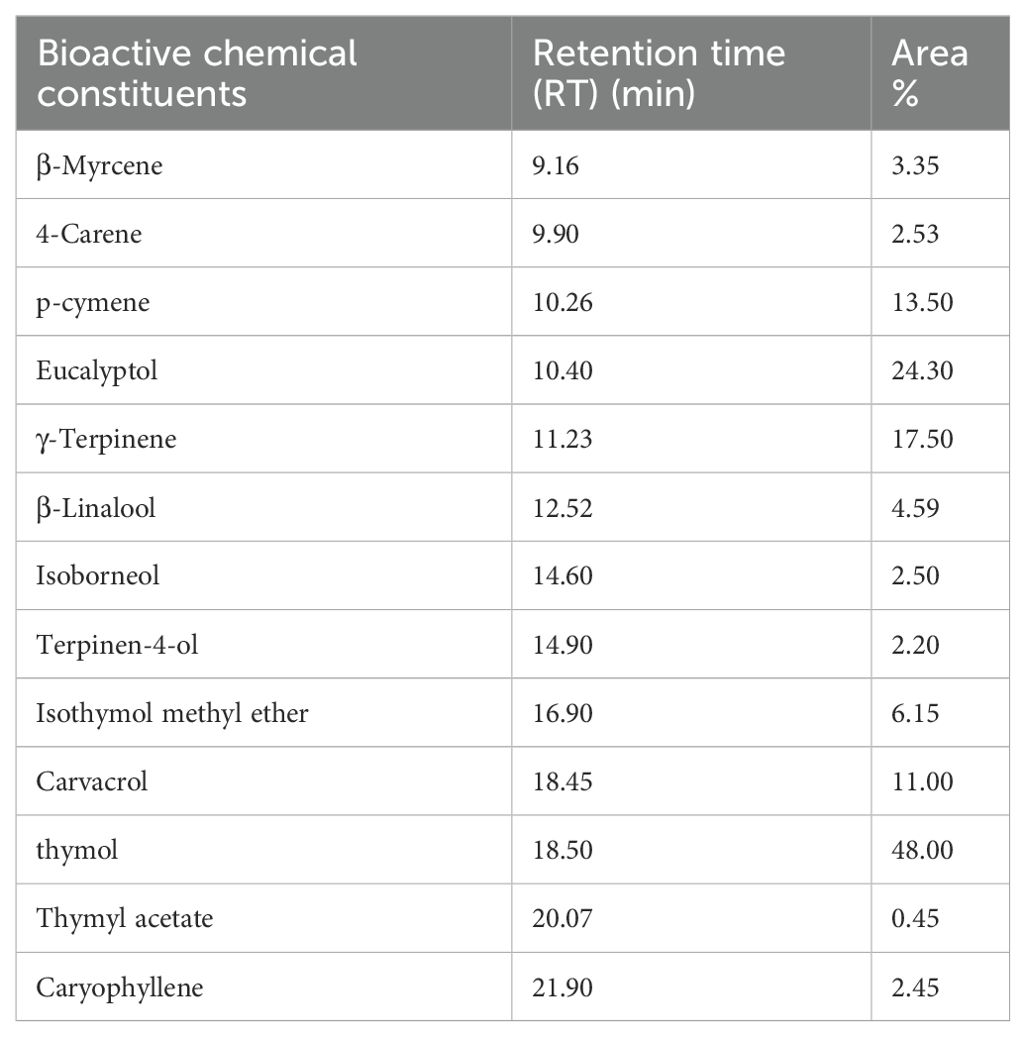
Table 2. Bioactive chemical components identified in thyme oil using gas chromatography–mass spectrometry (GC-MS) analysis.
Effect of dietary supplementation with TO on growth performance of broiler chickens
The growth performance measurements of experimental birds are displayed in Figure 1. All concentrations of TO significantly boosted the BWG between 28 and 42 days of age (P = 0.0129) and overall BWG (1–42 days) (P = 0.0010) compared with control chickens (Figure 1).
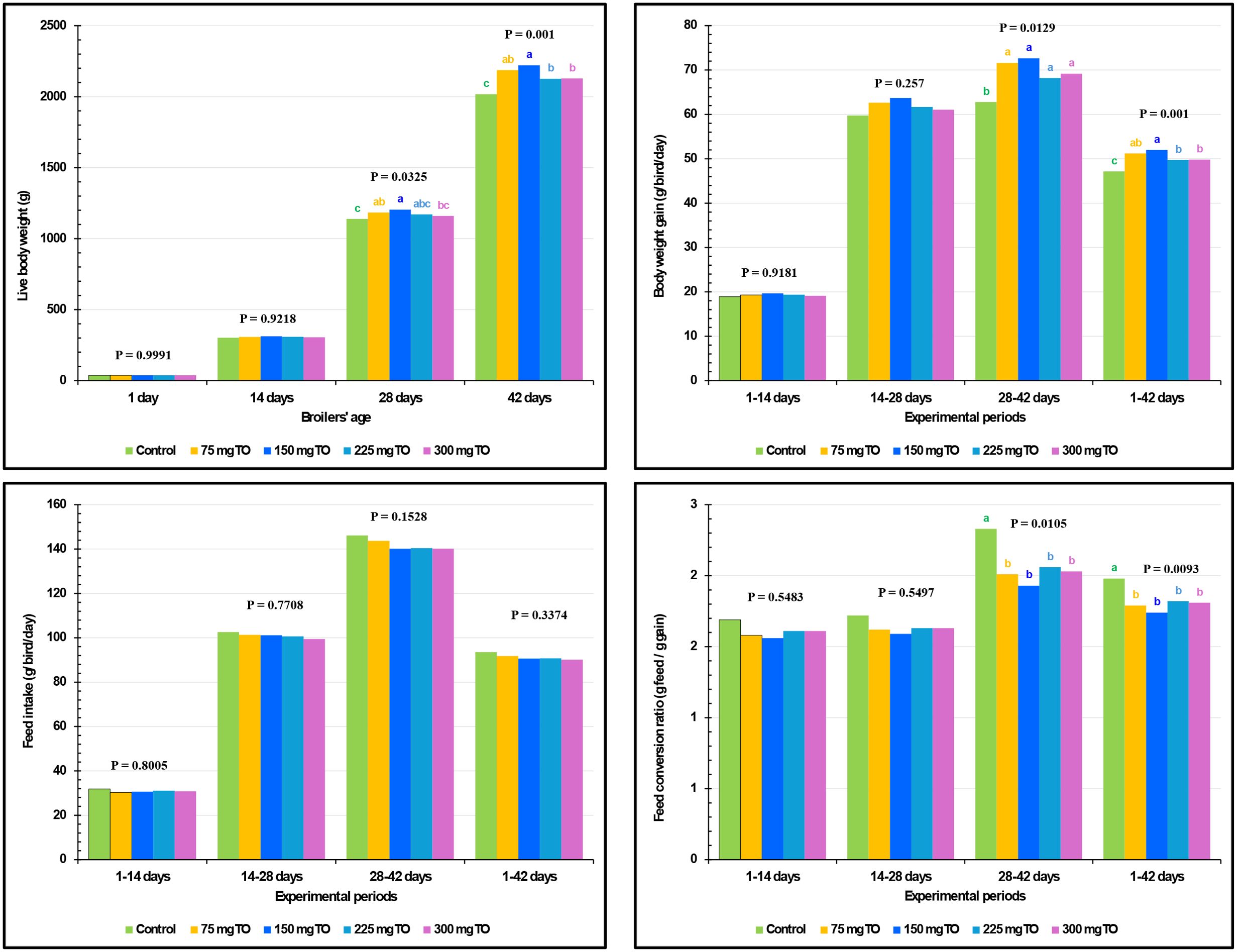
Figure 1. Impact of dietary supplementation with varying concentrations of thyme oil (TO) on the growth performance of broiler chickens.
The use of 150 mg/kg of TO was found to induce the highest final BW (P = 0.0010) followed by the 75 mg/kg diet, and then 225 and 300 mg/kg. Remarkably, at every studied interval, TO supplementation did not (P>0.05) affect FI. The addition of TO at all levels significantly improved FCR compared with the control birds during the intervals of 28-42 (P = 0.0105) and 1-42 (P = 0.0093) days (Figure 1).
Effect of dietary supplementation with TO on digestive enzymes of broiler chickens
Protease, amylase, trypsin, and lipase levels rose in TO-supplemented groups, depending on the dose (Table 3). Beginning at the 150-mg/kg diet, TO dietary inclusion induced higher protease (P<0.0001), amylase (P<0.0001), trypsin (P = 0.0043), and lipase (P = 0.0001) levels than the control group (Table 3).

Table 3. Effect of dietary supplementation with varying concentrations of thyme oil on the digestive enzymes of broiler chickens.
Effect of dietary supplementation with TO on the cecal microbiota of broiler chickens
Table 4 shows that dietary TO inclusion in broiler chicken diets at all doses significantly reduced counts of total bacteria (P = 0.0003), total mold and yeast (P = 0.0002), Salmonella (P<0.0001), and E. coli (P<0.0001) compared with the control.

Table 4. Effect of dietary supplementation with varying concentrations of thyme oil on cecal microbiota of broiler chickens.
TO supplementation reduced the E. coli and Salmonella counts in a dose-dependent way (Table 4). However, compared with the control, TO supplementation significantly increased the lactic acid bacterial count (P = 0.0034) at 150, 225, and 300 mg/kg.
Histopathological findings
Normal architectures of columnar enterocytes lining the mucosal villi, submucosal layer, and muscular layer were seen in all examined groups (Figure 2). Moreover, enhanced morphological structures of intestinal layers, primarily villi, were observed (0, 75, 150, 225, 300 of TO mg/kg, respectively, in Figures 2A–E).
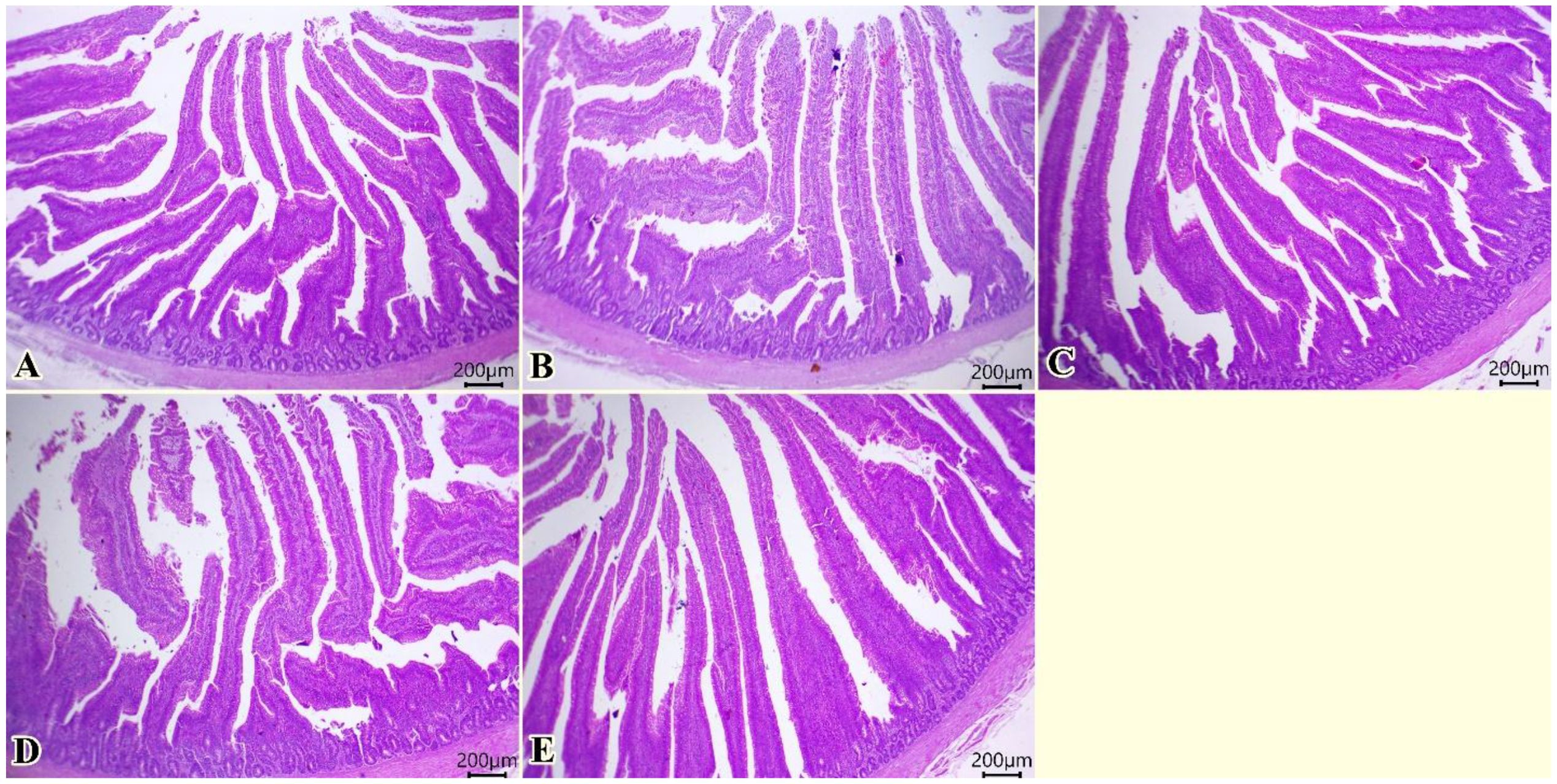
Figure 2. Photomicrograph of histopathological sections of the intestine (A–E) (scale bar 200 µm) stained with hematoxylin and eosin showing normal architectures of columnar enterocytes lining the mucosal villi, submucosal layer, and muscular layer with enhanced morphological structures of intestinal layers primarily villi. Panels (A–E) correspond to 0, 75, 150, 225, and 300 mg/kg of thyme oil, respectively.
Table 5 shows that dietary TO supplementation had a significant effect on VL and CD, with both parameters increasing progressively (P = 0.003 and P = 0.041, respectively) as the inclusion level rose from 150 to 300 mg TO/kg diet. Similarly, the ASA was significantly improved by TO supplementation, reaching its highest values (P = 0.043) at 225 and 300 mg/kg. In contrast, VW at the dose of 75 mg/kg of TO was not significantly influenced (P = 0.166) by dietary treatments (Table 5).

Table 5. Effect of dietary supplementation with varying concentrations of thyme oil on intestinal morphology of broiler chickens.
The liver of different groups (Figures 3A–E) showed normal histological structures of hepatic acini, Kupffer cells, sinusoids, and central veins. The hepatocytes were spherical cells with slightly acidophilic cytoplasm and centrally rounded vesicular nuclei. Intracytoplasmic vacuolations due to either glycogen or fat deposits, with centrally located nuclei, were seen in some examined sections (Figure 3).
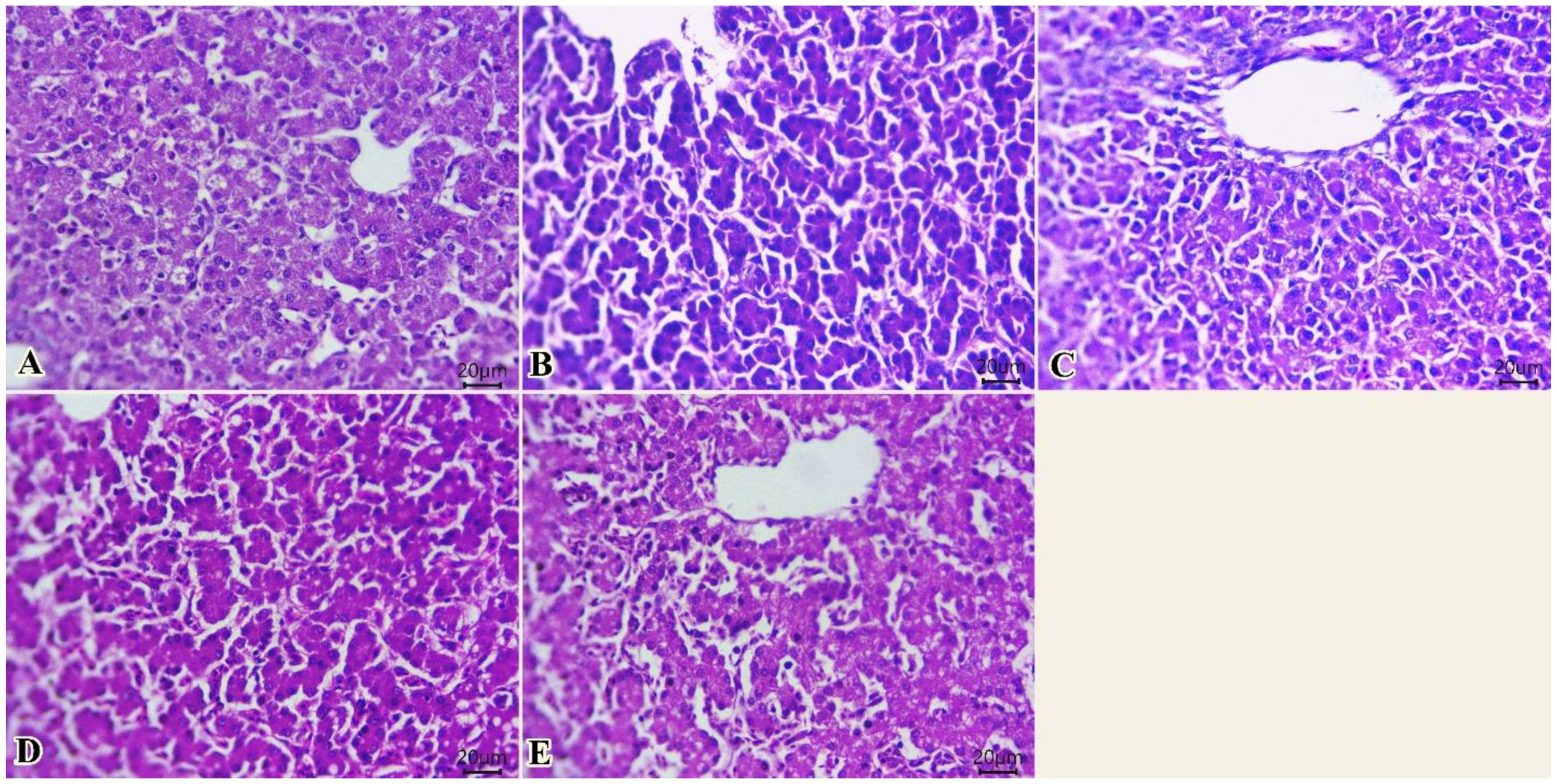
Figure 3. Photomicrograph of histopathological sections of the liver (A–E) (scale bar 20 µm) stained with hematoxylin and eosin showing normal histological structures of hepatic acini, Kupffer cells, sinusoids, and central veins with intracytoplasmic vacuolations with centrally located nuclei. Panels (A–E) correspond to 0, 75, 150, 225, and 300 mg/kg of thyme oil, respectively.
The bursa of Fabricius (Figures 4A–E) showed normal mucosal lining epithelium in addition to different sizes of cortical and medullary lymphoid follicles in all examined groups. Improvements in the activity of bursal lymphoid follicles, particularly at medullary regions, were gradually seen (0, 75, 150, 225, and 300 of TO mg/kg) (Figures 4A–E).
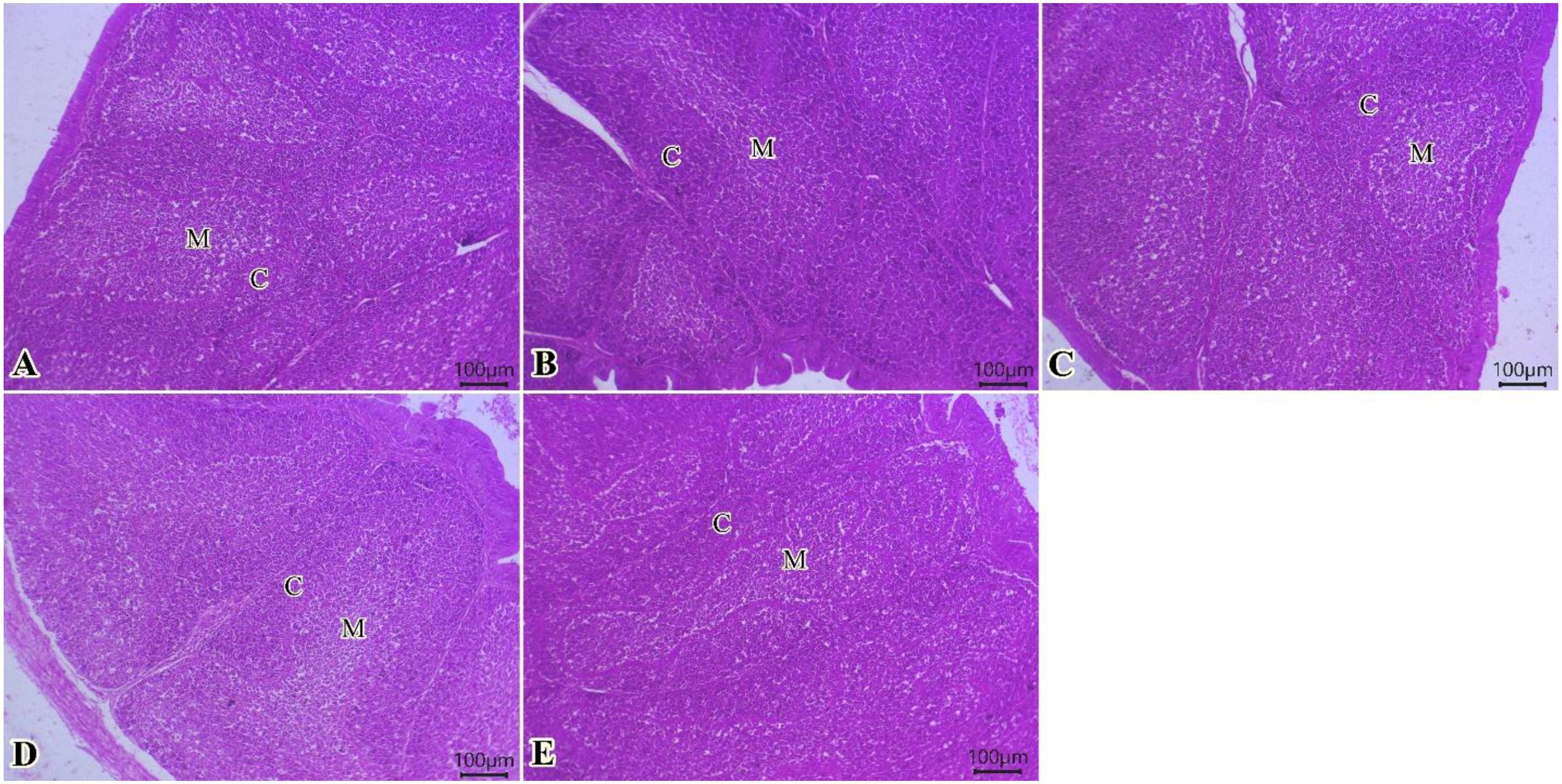
Figure 4. Photomicrograph of histopathological sections of the bursa (A–E) (scale bar 100 µm) stained with hematoxylin and eosin showing normal mucosal lining epithelium in addition to different sizes of cortical and medullary lymphoid follicles in all examined groups. Improvement in the activity of bursal lymphoid follicles, particularly in the medullary regions, was gradually observed. Panels (A–E) correspond to 0, 75, 150, 225, and 300 mg/kg of thyme oil, respectively. Cortical (C) and medullary (M) regions of bursal follicles.
Sections from spleen from all examined groups (Figures 5A–E) showed preserved histological architectures of white pulp and normal red pulp that involve splenic sinusoids, a network of reticular fibers with lymphocytes, and macrophages. The increased contour of the lymphoid populations in the white pulp was gradually observed (0, 75, 150, 225, and 300 of TO mg/kg) (Figures 5A–E).
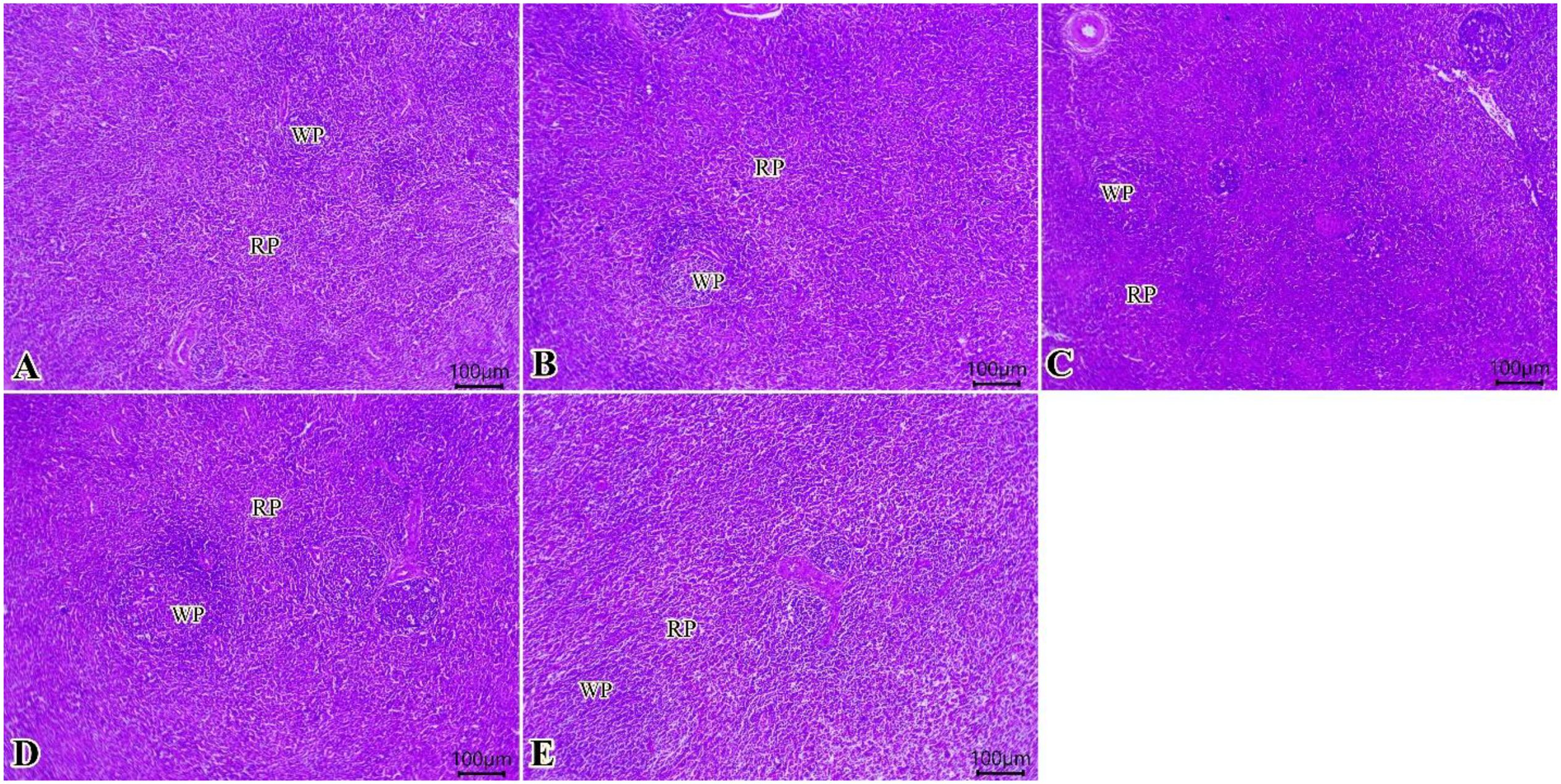
Figure 5. Photomicrograph of histopathological sections of the spleen (A–E) (scale bar 100 µm) stained with hematoxylin and eosin showing preserved histological architectures of white pulp and normal red pulp. A gradual increase in the contour of the white pulp lymphoid populations was observed. Panels (A–E) correspond to 0, 75, 150, 225, and 300 mg/kg of thyme oil, respectively. White pulp (WP) and red pulp (RP).
Effect of dietary supplementation with TO on immune responses and hematological indices of broiler chickens
Among the tested immunoglobulins, IgA did not exhibit any statistically significant (P = 0.6998) changes due to the addition of 75 mg/kg of TO (Table 6). Significantly higher levels of IgM (P = 0.0066), IgG (P = 0.0323), and C3 (P = 0.0001) were induced by TO at 150, 225, and 300 mg/kg than control. TO at all doses significantly and dose-dependently increased lysozyme levels (P = 0.0043) compared with the control group (Table 6).
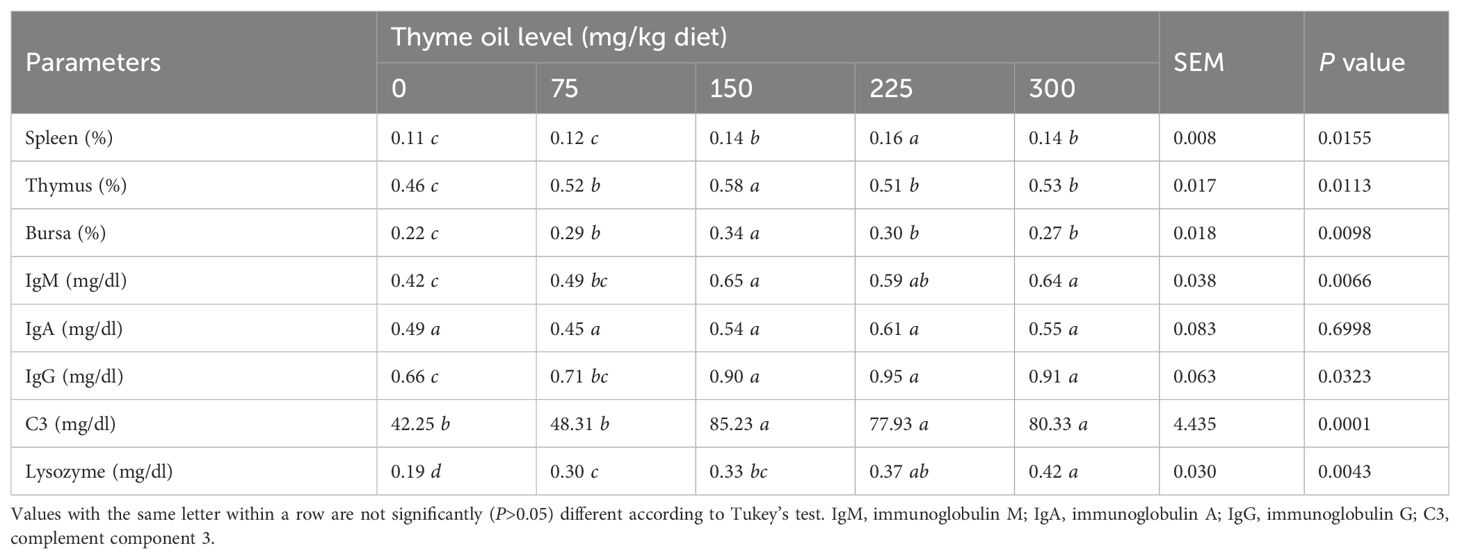
Table 6. Impact of dietary supplementation with varying concentrations of thyme oil on immunological parameters of broiler chickens.
Regarding the immune organ relative weights, the indices of spleen, thymus, and bursa were increased by all doses of TO inclusion (Table 6). Compared with the control birds, TO supplementation significantly enlarged the thymus index (P = 0.0113) at 75, 150, 225, and 300 mg/kg, the bursa index (P = 0.0098) at 75, 150, 225, and 300 mg/kg, and the spleen index (P = 0.0155) at 150, 225, and 300 mg/kg of TO (Table 6).
Table 7 shows that the birds supplemented with TO at 150, 225, or 300 mg/kg diet presented significantly higher Hb (P = 0.0058), RBCs (P = 0.0070), and WBCs (P = 0.0279) than control birds. Hb, RBCs, and WBCs were most significantly (P<0.05) affected by 150, 225, and 300 mg/kg of TO in the feed (Table 7).

Table 7. Impact of dietary supplementation with varying concentrations of thyme oil on hematological parameters of broiler chickens.
Effect of dietary supplementation with TO on liver and renal functions of broiler chickens
Among liver enzymes, AST was significantly decreased (P = 0.0002) by all TO doses, with a dose-dependent effect. The AST/ALT ratio was unaffected (P = 0.1768) by TO inclusion (Table 8). TO supplementation improved kidney function, as evidenced by reductions in creatinine and urea levels (P = 0.0154 and P = 0.0232, respectively) following TO administration.

Table 8. Effect of dietary supplementation with varying concentrations of thyme oil on liver and kidney functions of broiler chickens.
A significant effect was observed at 75, 150, 225, and 300 mg/kg of TO for creatinine, and at 225 and 300 mg/kg for urea. In contrast, uric acid levels were not affected (P = 0.1523) by 75, 150, and 225 mg/kg of TO (Table 8).
Effect of dietary supplementation with TO on the blood biochemical parameters of broiler chickens
Blood Mg, Ca, and Fe were increased (P = 0.0017, 0.0003, and 0.0033, respectively) by the dietary inclusion of TO, whereas P showed no statistical (P = 0.9313) difference (Table 9). Supplementation with TO at doses ≥150 mg/kg significantly increased Mg and Ca, and at 75 and 150 mg/kg, it significantly elevated Fe compared with the control (Table 9).
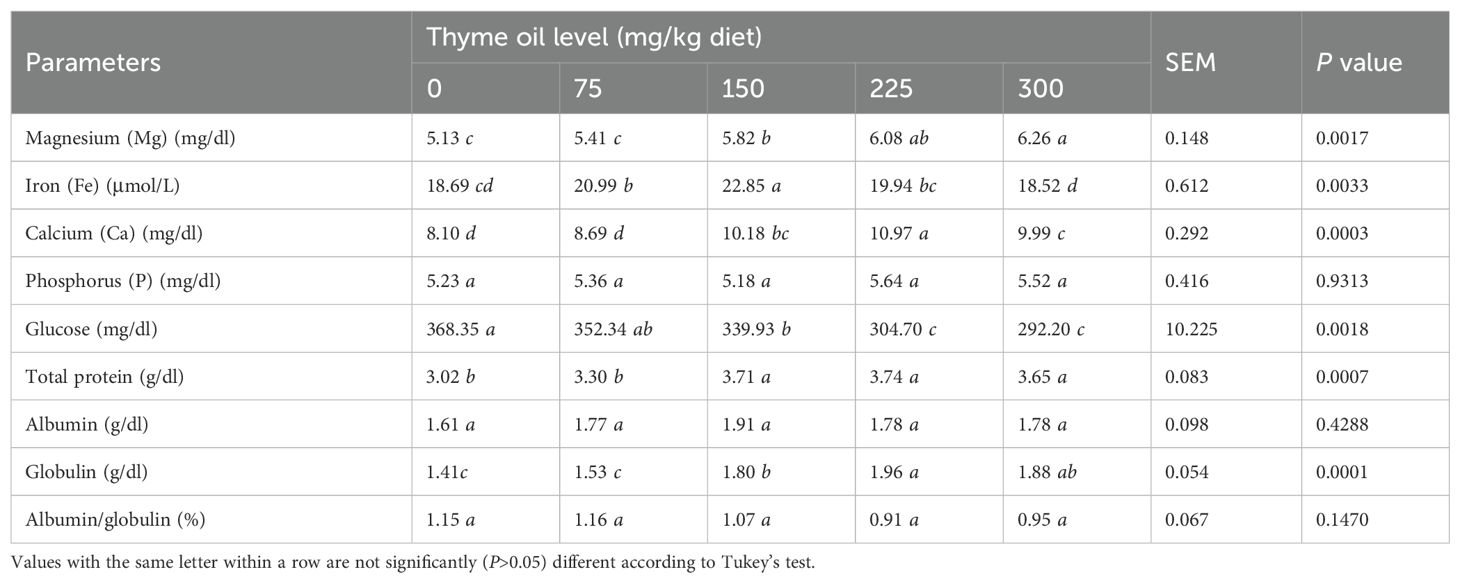
Table 9. Effect of dietary supplementation with varying concentrations of thyme oil on blood biochemical parameters of broiler chickens.
Blood mineral levels were most positively affected overall by a diet containing 150 mg/kg of TO. The inclusion of TO at ≥150 mg/kg increased total protein and globulin (P = 0.0007 and 0.0001, respectively), whereas albumin did not alter statistically (P = 0.4288).
The birds supplemented with TO at 75, 150, 225, or 300 mg/kg diet presented with lower glucose levels (P = 0.0018) than control birds. TO at 225 and 300 mg/kg diet significantly reduced glucose compared with 75 and 150 mg/kg of the diet (Table 9).
Effect of dietary supplementation with TO on antioxidant parameters of broiler chickens
Dietary TO supplementation at 75, 150, 225, and 300 mg/kg significantly reduced oxidative stress, as indicated by decreased MDA levels (P = 0.0006) compared with the 0 mg/kg diets. Likewise, the levels of different antioxidants were comparable between birds that received TO at 0 and 75 mg/kg of the diet (Table 10).

Table 10. Impact of dietary supplementation with varying concentrations of thyme oil on antioxidant parameters of broiler chickens.
The additions of 150–300 mg/kg of TO raised CAT (P = 0.0017) and TAC (P = 0.0170) levels, whereas dietary additions of 150, 225, and 300 mg/kg enhanced GSH (P = 0.0296) and SOD (P = 0.0340) levels compared with the 0 mg/kg diets (Table 10). Serum GST activity showed no statistical (P = 0.3173) differences across treatments (Table 10).
Effect of dietary supplementation with TO on lipid profile of broiler chickens
Table 11 shows that broiler chickens given dietary TO at all doses had significantly lower total cholesterol (P = 0.0015), triglycerides (P = 0.0008), LDL (P = 0.0001), VLDL (P = 0.0008), and LDL/HDL ratios (P = 0.0002), while having significantly higher HDL (P = 0.0134) only at 225 and 300 mg of TO/kg diet than non-supplemented birds (Table 11). Compared with the non-supplemented diet, the 300-mg/kg diet produced the highest HDL level, followed by the 225-mg/kg diet (Table 11).

Table 11. Effect of dietary supplementation with varying concentrations of thyme oil on lipid profile of broiler chickens.
Effect of dietary supplementation with TO on carcass traits of broiler chickens
No significant changes were seen between birds receiving 75, 225, and 300 mg/kg of TO and those on non-supplemented diets regarding carcass percentage (P = 0.5762) (Table 12). Furthermore, no significant differences were observed between birds receiving 75 or 225 mg/kg of TO and those on non-supplemented diets for dressing (P = 0.4097), giblets (P = 0.1557), and heart (P = 0.3904) at 42 days of age. No significant differences were observed between birds receiving 75, 150, 225, and 300 mg/kg of TO and those on non-supplemented diets in liver percentage (P = 0.8092) at 42 days of age.

Table 12. Effect of dietary supplementation with varying concentrations of thyme oil on carcass traits and relative organs of broiler chickens.
However, diets supplemented with 150 to 300 mg/kg of TO significantly increased gizzard percentage (P = 0.0252) compared with diets supplemented with 0 or 75 mg/kg of TO (Table 12).
Effect of nutritional supplementation of TO on the economic assessment of broiler chickens
Figure 6 displays the impact of adding various quantities of TO to the diet of broiler chickens on NR, EE, and relative economic efficiency (REE) at 6 weeks of age. Higher economic indices (NR, EE, and REE) were achieved in broiler groups fed a diet containing 150 mg/kg (Figure 6).
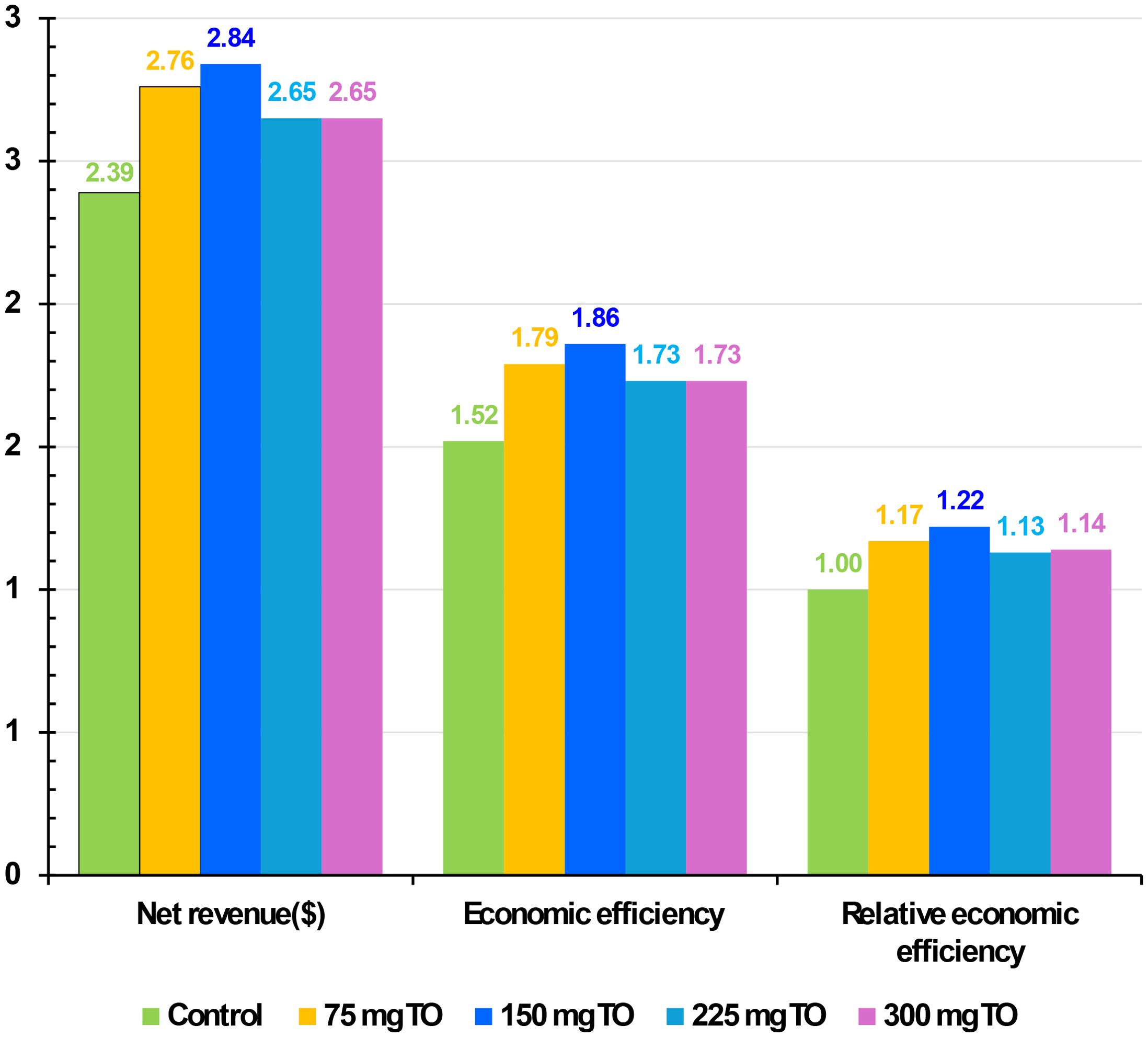
Figure 6. Effect of nutritional supplementation with different amounts of thyme oil (TO) on the economic assessment of broiler chickens.
This was followed by the broiler group receiving 75 mg/kg of TO, then both 225 and 300 mg/kg of TO (Figure 6). In contrast, the lowest values across all economic aspects were recorded in the control group (Figure 6).
Discussion
The findings of several studies regarding the effect of TO supplementation on chicken growth performance were inconsistent. Several reports indicated no significant changes in BWG, FI, or FCR at 120 mg/kg (29), 0.05%–0.1% (30), or 1–2 g/kg, respectively (17). Similarly, diets containing 100–300 mg/kg TO did not alter BWG or FCR, although FI was enhanced at 100 and 200 mg/kg (18).
Shamma et al. (31) observed that 0.4 mL/kg TO reduced FI and improved FCR, despite no significant effect on BWG, whereas 300 mg/kg TO depressed both BWG and FI (32). The BWG and FCR results are consistent with those of Wade et al. (33) and Moustafa et al. (34), who reported that 100 mg/kg of TO significantly improved BWG and FCR.
In addition, the present study demonstrated that feeding broilers TO for 42 days significantly improved final BW, overall BWG, and FCR at all tested levels without affecting FI. These results agree with previous findings in broilers, quail, and ducks (35–38). The inconsistent results of the previous studies may be due to differences in the chemical composition of the oil, bird strains and other genetic backgrounds, housing and environmental conditions, management practices, or variations in experimental designs.
The animals’ metabolism, nutrition, and overall health were directly indicated using blood biochemical indices. This was demonstrated by the notable improvement in blood, protein, and mineral profiles. However, blood albumin levels were unaffected by TO supplementation at any dose (except 150 mg/kg), and only doses of 150, 225, and 300 mg/kg significantly reduced blood glucose (P<0.05). However, Noruzi et al. (39) had comparable results for albumin, showing that 250 mg/kg of thyme essential oil had no effect on blood albumin levels but did not affect blood glucose levels. In line with the present findings, adding dietary thyme from various forms—powder or oil—significantly improved WBCs, lymphocytes, and heterophils and raised hematological parameters (40). Consequently, in broiler chickens, thyme essential oils may improve protein metabolism and fortify the immune system (36, 41).
All TO levels improved liver function, with AST levels significantly reduced as the TO dose increased (P<0.05). Increased AST levels in animals and birds indicate degenerative liver disorders and alterations (42). A similar effect on the liver was observed by Moustafa et al. (34), where the serum activity of liver transaminases was significantly lower in birds fed TO at 100 mg/kg than in the controls. However, broilers fed TO at 100, 200, and 300 mg/kg showed insignificant variations in their blood activity of ALT and AST (18).
Furthermore, the current study showed that supplementing broiler chickens with TO for 42 days improved renal function by lowering creatinine, uric acid, and urea levels. These outcomes align with the findings of Gumus et al. (43), where the serum creatinine concentration of quails fed TO at 150, 300, and 450 mg/kg was decreased linearly in comparison with the non-supplemented group. Furthermore, feeding layers 6 and 9 g of thyme powder/kg diet significantly decreased the blood content of urea compared with the controls (44). Therefore, thyme essential oil can help broiler health, performance, and liver and kidney functions (45). However, in the present study, there was no significant effect on the percentage of carcass, liver, and heart due to TO feeding, which is consistent with that of Adam et al. (40).
Our findings showed that groups fed TO had significantly improved lipid profiles, consistent with those of Adam et al. (40). This effect could be related to the antioxidant capabilities of the thyme plant, as well as its capacity to inhibit the actions of specific lipases in vivo, regulate and control hormone levels, increase lipid catabolism, decrease fat deposition, and promote protein deposition in the body (41).
TO has antioxidant activity, in addition to immune-stimulating and antimicrobial properties, which help increase production efficiency. Oxidative stress is a significant factor affecting the general health and growth performance of chickens, and it is the imbalance between reactive oxygen species generation and antioxidant defense mechanisms (14). Therefore, oxidative stress was indicated by the elevated MDA and low levels of antioxidant activity (46).
The inclusion of TO in broiler chicken feed at a minimum dosage of 150 mg/kg in the current study improved some antioxidant parameters (SOD, CAT, TAC, and GSH) and significantly decreased lipid peroxidation (MDA). These results are consistent with those of Placha et al. (30) and AbdelGhaney et al. (47). The antioxidant activity correlates with the presence of phenolic compounds and the essential oil content (48).
The indices of the lymphoid organs (thymus, spleen, and bursa), the three main immunological organs in chickens, could be utilized to determine the immunological status (49). The bursa is more readily impacted by nutrition than the other lymphoid organs (50). The immune organ indices IgM, IgG, C3, and lysozyme were significantly increased by TO supplementation at 150, 225, and 300 mg/kg compared with the control. According to several studies, thyme extracts, oils, or powder strengthen the immune system by increasing the development of antibodies against avian viruses and the immunological response to viral vaccinations (1, 19, 41) and improving serum cytokine levels (INF-γ and IL-10) (47).
Generally, improvements in digestive system function, influenced by intestinal microbiota, histomorphology, and digestive enzymes, are linked to improved growth performance. The production of digestive enzymes (protease, amylase, trypsin, and lipase) was significantly increased on the 42nd day with TO supplementation at 150, 225, and 300 mg/kg in the diet (Table 3). Birds supplemented with an equal mixture of thymol + carvacrol at levels 60, 100, and 200 mg/kg of feed, intestinal and pancreatic trypsin, lipase, and protease activities increased at 24 days old, but not at 42 days old (51). These elevated digestive enzyme levels in the current study may improve feed efficiency by improving the digestion and utilization of protein, fat, and carbohydrates.
Numerous studies have demonstrated how controlling gut bacteria can enhance growth performance (52, 53). In the present work, supplementing diets with TO at all tested levels (Table 4) significantly reduced pathogen counts, whereas lactic acid bacteria were increased. These findings align with those of Gheisar et al. (54), who reported that feeding broiler chickens a 0.075% essential oil mix (including TO) boosted the population of Lactobacillus. These effects are attributed to the phenolic components of TO, mainly thymol and carvacrol, which exert antibacterial action by disrupting bacterial membranes (55).
Zhu et al. (52) further reported that dietary plant extracts enriched with carvacrol and thymol improved cecal microbiota diversity and activated multiple metabolic pathways, including protein digestion, amino acid metabolism, and the citric acid cycle. Similarly, thymol supplementation altered microbial composition and metabolic profiles in piglets (56), leading to the production of short-chain fatty acids such as propionate and butyrate that enhance gut barrier function and confer anti-inflammatory benefits. It should be noted that the microbiological analyses in this study were limited to culture-based enumeration, which may not fully reflect the complexity of the cecal microbial community. Future studies could use 16S rRNA gene sequencing or metagenomic approaches to gain a deeper, more comprehensive understanding of gut microbiota dynamics.
The crypts and villi of the intestinal absorptive epithelium critically determine the intestinal capacity for nutrient absorption (57, 58). In the current study, significant increases in VL, VW, ASA, CD, and VL/CD were observed with 150, 225, and 300 mg/kg of TO (Table 5), indicating enhanced intestinal histomorphology.
Enhancing intestinal histomorphology, besides gut health, immune status, antioxidant capacity, liver and kidney functions, hematological parameters, digestive enzymes, and blood minerals through TO supplementation (150–300 mg/kg), improves nutrient utilization and growth performance, thereby reducing feed costs per unit of gain and increasing economic efficiency in broiler production. The third group (150 mg/kg diet) achieved the best values of NR and EE when compared with the other groups and the control. The TO can positively affect the economics of broiler chickens by improving BWG, FCR, and livability, thereby reducing the cost per kilogram of BWG. This is achieved through multiple mechanisms, including improving immune responses, stimulating intestinal enzymes, and possessing antioxidant properties. Furthermore, the specific economic benefits depend on the level, the presence of stressors like temperature, and general management practices.
Conclusion
Providing broiler chickens with feed containing TO resulted in a growth-enhancing effect; however, FI remained essentially unchanged. Improvements in digestive enzyme activity, intestinal morphology, and modulation of cecal microbiota (reducing pathogenic bacteria whereas increasing lactic acid bacteria) may have contributed to enhanced growth performance. TO demonstrated antioxidant properties by reducing MDA levels and enhancing antioxidant enzyme activity, whereas immunological-stimulatory benefits were indicated by increased immune organ indices, immunoglobulin levels, Hb level, and the counts of RBC and WBC.
The lipid profile improved with increased HDL and decreased LDL, VLDL, total cholesterol, and triglycerides. Carcass characteristics, however, were not significantly affected. The net revenue and economic efficiency of treated broilers were improved with TO supplementation. While supplementation with 150 mg/kg of TO appeared to provide the most pronounced benefits under the present controlled experimental conditions, this recommendation should be considered cautiously, given limitations such as the study’s short duration and the absence of challenge trials. Further research is needed to confirm the optimal inclusion level under practical field conditions.
Data availability statement
The original contributions presented in the study are included in the article/supplementary material. Further inquiries can be directed to the corresponding author.
Ethics statement
This study was conducted at a private poultry farm in San El Hagar, Sharkia Governorate, Egypt, in accordance with the ethical guidelines established by the Poultry Department of Zagazig University. All laboratory analyses, experimental procedures, and protocols adhered to the ethical standards set by the Committee of Animal Care and Welfare at Zagazig University, Egypt, under Ethical Approval No. (ZU-IACUC/2/F/313/2023). The studies were conducted in accordance with the local legislation and institutional requirements. Written informed consent was obtained from the owners for the participation of their animals in this study.
Author contributions
MAl: Writing – original draft, Writing – review & editing. AS: Writing – original draft, Writing – review & editing. AA: Supervision, Writing – original draft, Writing – review & editing. FR: Supervision, Writing – original draft, Writing – review & editing. ME-K: Supervision, Writing – original draft, Writing – review & editing. MA-B: Funding acquisition, Writing – original draft, Writing – review & editing. MAz: Project administration, Writing – original draft, Writing – review & editing. AD: Writing – original draft, Writing – review & editing. KE-T: Writing – original draft, Writing – review & editing. AE: Supervision, Writing – original draft, Writing – review & editing.
Funding
The author(s) declared financial support was received for this work and/or its publication. This work was funded by the Ongoing Research Funding Program (ORF-1096), King Saud University (Riyadh, Saudi Arabia). This project was also funded by the UAEU Advanced Research Program (Grant number: 12S169) to KE-T.
Acknowledgments
This work was funded by the Ongoing Research Funding Program (ORF-1096), King Saud University (Riyadh, Saudi Arabia).
Conflict of interest
The authors declare that the research was conducted in the absence of any commercial or financial relationships that could be construed as a potential conflict of interest.
The author(s) declared that they were an editorial board member of Frontiers, at the time of submission. This had no impact on the peer review process and the final decision.
Generative AI statement
The author(s) declare that no Generative AI was used in the creation of this manuscript.
Any alternative text (alt text) provided alongside figures in this article has been generated by Frontiers with the support of artificial intelligence and reasonable efforts have been made to ensure accuracy, including review by the authors wherever possible. If you identify any issues, please contact us.
Publisher’s note
All claims expressed in this article are solely those of the authors and do not necessarily represent those of their affiliated organizations, or those of the publisher, the editors and the reviewers. Any product that may be evaluated in this article, or claim that may be made by its manufacturer, is not guaranteed or endorsed by the publisher.
References
1. El-Shall NA, Shewita RS, Abd El-Hack ME, AlKahtane A, Alarifi S, Alkahtani S, et al. Effect of essential oils on the immune response to some viral vaccines in broiler chickens, with special reference to Newcastle disease virus. Poult Sci. (2020) 99:2944–54. doi: 10.1016/j.psj.2020.03.008
2. El-Shall NA, Jiang S, Farag MR, Azzam M, Al-Abdullatif AA, Alhotan R, et al. Potential of Spirulina platensis as a feed supplement for poultry to enhance growth performance and immune modulation. Front Immunol. (2023) 14:1072787. doi: 10.3389/fimmu.2023.1072787
3. El-Shall NA, Awad AM, El-Hack ME, Naiel MAE, Othman SI, Allam AA, et al. The simultaneous administration of a probiotic or prebiotic with live Salmonella vaccine improves growth performance and reduces fecal shedding of the bacterium in Salmonella-challenged broilers. Animals. (2019) 10:70. doi: 10.3390/ani10010070
4. Fornazier R, Ribeiro Junior V, Albino LF, Rodrigues D, deC. TF, da Silva D, et al. A symbiotic improves performance and carcass yield of broilers. J Appl Poult Res. (2019) 28:383–9. doi: 10.3382/japr/pfy082
5. Puvača N, Tufarelli V, and Giannenas I. Essential oils in broiler chicken production, immunity and meat quality: review of. Thymus vulgaris Origanum vulgare Rosmarinus officinalis. Agric. (2022) 12:874. doi: 10.3390/agriculture12060874
6. Metwally M. Efficacy of different medicinal herbs blends as feed additives on the performance, breast meat composition, nutrient digestibility, tibia bone characteristics and economical evaluation of Japanese quail. Egypt Poult Sci J. (2023) 43:371–89. doi: 10.21608/epsj.2023.305342
7. Hoepers PG, Nunes PLF, Almeida-Souza HO, Martins MM, Carvalho RD de O, Dreyer CT, et al. Harnessing probiotics capability to combat Salmonella Heidelberg and improve intestinal health in broilers. Poult Sci. (2024) 103:103739. doi: 10.1016/j.psj.2024.103739
8. Alagawany M, Hegazy MI, Farag MR, El-Shall NA, Sallam SM, and Dhama K. Probiotics, prebiotics, and synbiotics in animal and poultry nutrition. In: Alagawany M, Sallam SM, and Abd El-Hack ME, editors. Organic Feed Additives for Livestock. Academic Press, Amsterdam, Netherlands (2025). pp. 17–41. doi: 10.1016/B978-0-443-13510-1.00002-5
9. Fadheel QJ and Mohammed RA. Evaluation of the antihypertensive effect of the thyme among patients suffering from hypertension in Iraq. Wiad Lek. (2023) 76:2614–24. doi: 10.36740/WLek202312110
10. Kowalczyk A, Przychodna M, Sopata S, Bodalska A, and Fecka I. Thymol and thyme essential oil—new insights into selected therapeutic applications. Molecules. (2020) 25:4125. doi: 10.3390/molecules25184125
11. Vassiliou E, Awoleye O, Davis A, and Mishra S. Anti-Inflammatory and Antimicrobial properties of thyme oil and its main constituents. Int J Mol Sci. (2023) 24:6936. doi: 10.3390/ijms24086936
12. Nieto G. A Review on applications and uses of Thymus in the food industry. Plants. (2020) 9:961. doi: 10.3390/plants9080961
13. Golshahi A, Shams Shargh M, Dastar B, and Rahmatnejad E. The effect of Thymus vulgaris extract and probiotic on growth performance, blood parameters, intestinal morphology, and litter quality of broiler chickens fed low-protein diets. Poult Sci. (2025) 104:104554. doi: 10.1016/j.psj.2024.104554
14. Oke OE, Akosile OA, Oni AI, Opowoye IO, Ishola CA, Adebiyi JO, et al. Oxidative stress in poultry production. Poult Sci. (2024) 103:104003. doi: 10.1016/j.psj.2024.104003
15. Hoffman-Pennesi D and Wu C. The effect of thymol and thyme oil feed supplementation on growth performance, serum antioxidant levels, and cecal Salmonella population in broilers. J Appl Poult Res. (2010) 19:432–43. doi: 10.3382/japr.2009-00141
16. Nazarizadeh H, Mohammad Hosseini S, and Pourreza J. Effect of plant extracts derived from thyme and chamomile on the growth performance, gut morphology and immune system of broilers fed aflatoxin B1 and ochratoxin A contaminated diets. Ital J Anim Sci. (2019) 18:1073–81. doi: 10.1080/1828051X.2019.1615851
17. Attia YA, Bakhashwain AA, and Bertu NK. Thyme oil (Thyme vulgaris L.) as a natural growth promoter for broiler chickens reared under hot climate. Ital J Anim Sci. (2017) 16:275–82. doi: 10.1080/1828051X.2016.1245594
18. Saleh N, Allam T, El-Latif AA, and Ghazy E. The effects of dietary supplementation of different levels of thyme (Thymus vulgaris) and ginger (Zingiber officinale) essential oils on performance, hematological, biochemical and immunological parameters of broiler chickens. Glob Vet. (2014) 12:736–44. Available online at: http://www.idosi.org/gv/gv12(6)14/1.pdf.
19. Hassanin O, El-Sebai A, El-Motaal SA, and Khalifa HA. Experimental trials to assess the immune modulatory influence of thyme and ginseng oil on NDV-vaccinated broiler chickens. Open Vet J. (2024) 14:398. doi: 10.5455/OVJ.2024.v14.i1.36
20. NRC. Nutrient Requirements of Poultry. 9th revised edition. Washington, DC, USA: The National Academies Press (1994). 176 p. doi: 10.17226/2114
21. Dein FJ. Laboratory Manual of Avian Hematology. East Northport, NY, USA: Association of Avian Veterinarian (1984). 38 p.
22. Irizarry-Rovira AR. Introduction to avian and reptilian clinical pathology. In: Cowell RL, editor. Veterinary Clinical Pathology Secrets. Hanley and Belfus, Philadelphia, USA (2004). p. 282–313. doi: 10.1016/B978-1-56053-633-8.X5001-3
23. Bain BJ, Bates I, and Laffan MA. Dacie and Lewis Practical Haematology. 12th Edition. Amsterdam, Netherlands: Elsevier (2020). 600 p.
24. Friedewald WT, Levy RI, and Fredrickson DS. Estimation of the concentration of low-density lipoprotein cholesterol in plasma, without use of the preparative ultracentrifuge. Clin Chem. (1972) 18:499–502. doi: 10.1093/clinchem/18.6.499
25. Mueller S, Riedel H-D, and Stremmel W. Determination of catalase activity at physiological hydrogen peroxide concentrations. Anal Biochem. (1997) 245:55–60. doi: 10.1006/abio.1996.9939
26. Bianchi ATJ, Moonen-Leusen HWM, van der Heijden PJ, and Bokhout BA. The use of a double antibody sandwich ELISA and monoclonal antibodies for the assessment of porcine IgM, IgG and IgA concentrations. Vet Immunol Immunopathol. (1995) 44:309–17. doi: 10.1016/0165-2427(94)05307-E
27. Xia MS, Hu CH, and Xu ZR. Effects of copper-bearing montmorillonite on growth performance, digestive enzyme activities, and intestinal microflora and morphology of male broilers. Poult Sci. (2004) 83:1868–75. doi: 10.1093/ps/83.11.1868
28. Bancroft JD and Gamble M. Theory and Practice of Histological Techniques. 7th edition. London, United Kingdom: Churchill Livingstone (2007). 725 p.
29. Tekeli A, Çelik L, Kutlu HR, and Görgülü M. (2006). Effect of dietary supplemental plant extracts on performance, carcass characteristics, digestive system development, intestinal microflora and some blood parameters of broiler chicks, in: Proceedings of the 12th European Poultry Conference, Verona, Italy, 10–14 September. pp. 10–4.
30. Placha I, Ocelova V, Chizzola R, Battelli G, Gai F, Bacova K, et al. Effect of thymol on the broiler chicken antioxidative defence system after sustained dietary thyme oil application. Br Poult Sci. (2019) 60:589–96. doi: 10.1080/00071668.2019.1631445
31. Shamma TA, El-Shafei AA, and A El-Yazby WA. Productive performance and some blood parameters of broiler chickens fed diets supplemented with thyme and lavender oils. J Anim Poult Prod. (2019) 10:359–63. doi: 10.21608/jappmu.2019.71180
32. Sariözkan S, Kocaoğlu Güçlü B, Konca Y, Aktuğ E, Kaliber M, Büyükkiliç Beyzi S, et al. The effects of thyme essential oil and vitamin combinations on performance, carcass quality and oxidation parameters in broilers exposed to heat stress. Ankara Üniversitesi Vet Fakültesi Derg. (2020) 67:357–64. doi: 10.33988/auvfd.626707
33. Wade MR, Manwar SJ, Kuralkar SV, Waghmare SP, Ingle VC, and Hajare SW. Effect of thyme essential oil on performance of broiler chicken. J Entomol Zool Stud. (2018) 6:25–8.
34. Moustafa N, Aziza A, Orma O, and Ibrahim T. Effect of supplementation of broiler diets with essential oils on growth performance, antioxidant status, and general health. Mansoura Vet Med J. (2020) 21:14–20. doi: 10.21608/mvmj.2020.21.103
35. Denli M, Okan F, and Uluocak AN. Effect of dietary supplementation of herb essential oils on the growth performance, carcass and intestinal characteristics of quail (Coturnix coturnix japonica). S Afr J Anim Sci. (2004) 34:174–9.
36. Zhu X, Liu W, Yuan S, and Chen H. The effect of different dietary levels of thyme essential oil on serum biochemical indices in mahua broiler chickens. Ital J Anim Sci. (2014) 13:3238. doi: 10.4081/ijas.2014.3238
37. Gheisar MM, Im YW, Lee HH, Il CY, and Kim IH. Inclusion of phytogenic blends in different nutrient density diets of meat-type ducks. Poult Sci. (2015) 94:2952–8. doi: 10.3382/ps/pev301
38. Pournazari M, Qotbi AA, Seidavi A, and Corazzin M. Prebiotics, probiotics and thyme (Thymus vulgaris) for broilers: performance, carcass traits and blood variables. Rev Colomb Cienc Pecu. (2017) 30:3–10. doi: 10.17533/udea.rccp.v30n1a01
39. Noruzi S, Torki M, and Mohammadi H. Effects of supplementing diet with thyme (Thymuas vulgaris L.) essential oil and/or selenium yeast on production performance and blood variables of broiler chickens. Vet Med Sci. (2022) 8:1137–45. doi: 10.1002/vms3.736
40. Adam A, Shihata S, and Abd El-Hady AM. Effect of thyme (Thymus vulgaris) on productive performance, carcass characteristics, blood hematology and lipid profile of broiler chicks of broiler chicks. Egypt Poult Sci J. (2020) 40:715–27. doi: 10.21608/epsj.2020.115573
41. Fallah R and Mirzaei E. Effect of dietary inclusion of turmeric and thyme powders on performance, blood parameters and immune system of broiler chickens. J Livest Sci Fallah Mirzaei J Livest Sci. (2016) 7:180–6.
42. Beaufrère H and Vergneau-Grosset C. Clinical pathology. In: Graham JE, Doss GA, and Beaufrère H, editors. Exotic Animal Emergency and Critical Care Medicine. John Wiley & Sons, Inc. Hoboken, New Jersey, USA (2021). pp. 563–81. doi: 10.1002/9781119149262.ch32
43. Gumus R, Ercan N, and Imik H. The effect of thyme essential oil (Thymus Vulgaris) added to quail diets on performance, some blood parameters, and the antioxidative metabolism of the serum and liver tissues. Braz J Poult Sci. (2017) 19:297–304. doi: 10.1590/1806-9061-2016-0403
44. Abd El-Hack ME and Alagawany M. Performance, egg quality, blood profile, immune function, and antioxidant enzyme activities in laying hens fed diets with thyme powder. J Anim Feed Sci. (2015) 24:127–33. doi: 10.22358/jafs/65638/2015
45. Fawaz MA, Ismail ZSH, Hassan HA, and Abdel-Wareth AAA. Effect of thyme essential oil on productive performance of broiler chickens a-review. SVU-International J Environ Res. (2021) 3:8–18. doi: 10.21608/svuijer.2021.215540
46. El-Maddawy ZK, El-Sawy AEF, Ashoura NR, Aboelenin SM, Soliman MM, Ellakany HF, et al. Use of zinc oxide nanoparticles as anticoccidial agents in broiler chickens along with its impact on growth performance, antioxidant status, and hematobiochemical profile. Life. (2022) 12:74. doi: 10.3390/life12010074
47. AbdelGhaney D, ElFar A, Sadek K, ElSayed Y, and AbdelLatif M. Impact of dietary thyme (Thymus Vulgaris) on broiler chickens concerning immunity, antioxidant status, and performance. Alexandria J Vet Sci. (2017) 55:169–79. doi: 10.5455/ajvs.275352
48. Urban J, Kareem KY, Matuszewski A, Bień D, Ciborowska P, Lutostański K, et al. Enhancing broiler chicken health and performance: the impact of phytobiotics on growth, gut microbiota, antioxidants, and immunity. Phytochem Rev. (2025) 24:2131–45. doi: 10.1007/s11101-024-09994-0
49. Zhu X, Tao L, Liu H, and Yang G. Effects of fermented feed on growth performance, immune organ indices, serum biochemical parameters, cecal odorous compound production, and the microbiota community in broilers. Poult Sci. (2023) 102:102629. doi: 10.1016/j.psj.2023.102629
50. Wu P, Golly MK, Guo Y, Ma H, He R, Luo X, et al. Effect of partial replacement of soybean meal with high-temperature fermented soybean meal in antibiotic-growth-promoter-free diets on growth performance, organ weights, serum indexes, intestinal flora and histomorphology of broiler chickens. Anim Feed Sci Technol. (2020) 269:114616. doi: 10.1016/j.anifeedsci.2020.114616
51. Hashemipour H, Kermanshahi H, Golian A, and Veldkamp T. Effect of thymol and carvacrol feed supplementation on performance, antioxidant enzyme activities, fatty acid composition, digestive enzyme activities, and immune response in broiler chickens. Poult Sci. (2013) 92:2059–69. doi: 10.3382/ps.2012-02685
52. Zhu N, Wang J, Yu L, Zhang Q, Chen K, and Liu B. Modulation of growth performance and intestinal microbiota in chickens fed plant extracts or virginiamycin. Front Microbiol. (2019) 10:1333. doi: 10.3389/fmicb.2019.01333
53. Meng WS, Zou Q, Xiao Y, Ma W, Zhang J, Wang T, et al. Growth performance and cecal microbiota of broiler chicks as affected by drinking water disinfection and/or herbal extract blend supplementation. Poult Sci. (2023) 102:102707. doi: 10.1016/j.psj.2023.102707
54. Gheisar MM, Hosseindoust A, and Kim IH. Evaluating the effect of microencapsulated blends of organic acids and essential oils in broiler chickens diet. J Appl Poult Res. (2015) 24:511–9. doi: 10.3382/japr/pfv063
55. Gheisar MM and Kim IH. Phytobiotics in poultry and swine nutrition – a review. Ital J Anim Sci. (2018) 17:92–9. doi: 10.1080/1828051X.2017.1350120
56. Li Y, Fu X, Ma X, Geng S, Jiang X, Huang Q, et al. Intestinal microbiome-metabolome responses to essential oils in piglets. Front Microbiol. (2018) 9:1988. doi: 10.3389/fmicb.2018.01988
57. Liu BY, Wang ZY, Yang HM, Wang XB, Hu P, and Lu J. Developmental morphology of the small intestine in Yangzhou goslings. Afr J Biotechnol. (2010) 9:7392–400. doi: 10.5897/AJB10.455
Keywords: broilers, economics, growth, intestinal morphology, microbiota, organic poultry, thyme
Citation: Saied AM, Attia AI, Reda FM, El-Kholy MS, Al-Badwi MA, Azzam M, Di Cerbo A, Alagawany M, El-Tarabily KA and EL Nagar AG (2025) Harnessing natural feed additives for sustainable production and economics: the role of Thymus vulgaris L. oil as an antimicrobial agent and a growth promoter in improving production and health of broiler chickens. Front. Immunol. 16:1695478. doi: 10.3389/fimmu.2025.1695478
Received: 29 August 2025; Accepted: 14 October 2025;
Published: 05 December 2025.
Edited by:
Muthukumar Serva Peddha, Central Food Technological Research Institute (CSIR), IndiaReviewed by:
Malarvizhi Arthanari, Vivekanandha College of Arts and Sciences for Women, IndiaSeema Mudhol, Sarada Vilas College of Pharmacy, India
Copyright © 2025 Saied, Attia, Reda, El-Kholy, Al-Badwi, Azzam, Di Cerbo, Alagawany, El-Tarabily and EL Nagar. This is an open-access article distributed under the terms of the Creative Commons Attribution License (CC BY). The use, distribution or reproduction in other forums is permitted, provided the original author(s) and the copyright owner(s) are credited and that the original publication in this journal is cited, in accordance with accepted academic practice. No use, distribution or reproduction is permitted which does not comply with these terms.
*Correspondence: Khaled A. El-Tarabily, a3RhcmFiaWx5QHVhZXUuYWMuYWU=
 Ahmed M. Saied1
Ahmed M. Saied1 Fayiz M. Reda
Fayiz M. Reda Mohamed S. El-Kholy
Mohamed S. El-Kholy Mahmoud Azzam
Mahmoud Azzam Alessandro Di Cerbo
Alessandro Di Cerbo Mahmoud Alagawany
Mahmoud Alagawany Khaled A. El-Tarabily
Khaled A. El-Tarabily